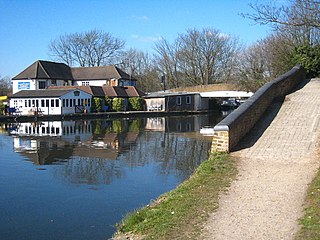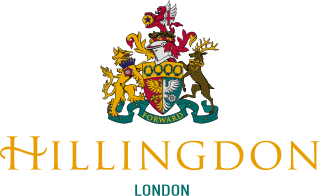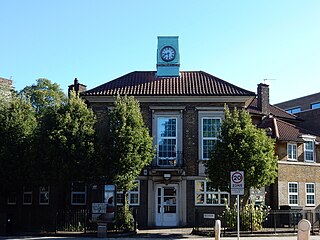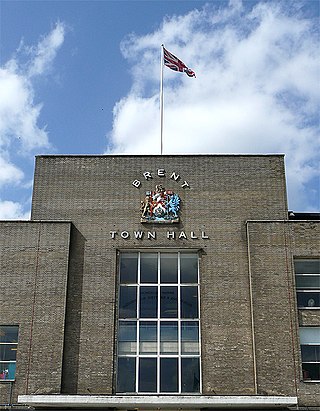
Cowley is a village contiguous with the town of Uxbridge in the London Borough of Hillingdon. A largely suburban village with 16 listed buildings, Cowley is 15.4 miles (24.8 km) west of Charing Cross, bordered to the west by Uxbridge Moor in the Green Belt and the River Colne, forming the border with Buckinghamshire. Cowley was an ancient parish in the historic county of Middlesex.

Northwood is an area in the London Borough of Hillingdon, North West London, located 14.5 miles (23.3 km) north-west of Charing Cross. Northwood was part of the ancient parish of Ruislip, Middlesex. The area was situated on the historic Middlesex boundary with Hertfordshire, and since being incorporated into Greater London in 1965, has been on the Greater London boundary with that county.

Ruislip is a suburb in the London Borough of Hillingdon in West London. Prior to 1965 it was in Middlesex. Ruislip lies 13.8 miles (22.2 km) west-north-west of Charing Cross, London.

Uxbridge is a suburban town in west London and the administrative headquarters of the London Borough of Hillingdon. Situated 15.4 miles (24.8 km) west-northwest of Charing Cross, it is one of the major metropolitan centres identified in the London Plan. Uxbridge formed part of the parish of Hillingdon in the county of Middlesex, and was a significant local commercial centre from an early time. As part of the suburban growth of London in the 20th century it expanded and increased in population, becoming a municipal borough in 1955, and has formed part of Greater London since 1965.

Yiewsley is a large suburban village in the London Borough of Hillingdon, England, 2 miles (3 km) south of Uxbridge, the borough's commercial and administrative centre. Yiewsley was a chapelry in the ancient parish of Hillingdon, Middlesex. The population of the ward was 12,979 at the 2011 Census.

The London Borough of Hillingdon is the largest and westernmost borough in West London, England. It was formed in 1965 from the districts of Hayes and Harlington, Ruislip-Northwood, Uxbridge, and Yiewsley and West Drayton in the ceremonial county of Middlesex. Today, Hillingdon is home to Heathrow Airport and Brunel University, and is the second largest of the 32 London boroughs by area.

RAF Uxbridge was a Royal Air Force (RAF) station in Uxbridge, within the London Borough of Hillingdon, occupying a 44.6-hectare (110-acre) site that originally belonged to the Hillingdon House estate. The British Government purchased the estate in 1915, three years before the founding of the RAF. Until the outbreak of the Second World War in 1939, the station was open to the public.

Hillingdon is an area of Uxbridge within the London Borough of Hillingdon, centred 14.2 miles (22.8 km) west of Charing Cross. It was an ancient parish in Middlesex that included the market town of Uxbridge. During the 1920s the civil parish bore a rapid, planned increase in population and housing, and was absorbed by Uxbridge Urban District in 1929. It has formed part of Greater London since 1965.

Uxbridge was a local government district in north west Middlesex, England, from 1849 to 1965, seated in the town of Uxbridge.

Yiewsley and West Drayton was a local government district in Middlesex, England from 1929 to 1965. Its area became the south-west of the London Borough of Hillingdon.

The Waterside building in Harmondsworth, Greater London, is the international head office of British Airways; it also houses the operational head office of BA's parent company, International Airlines Group (IAG). The building and landscaping, which cost £200 million, is on Harmondsworth Moor, northwest of Heathrow Airport, between the M4 and the M25 motorways in the linear Colne Valley regional park. Waterside is on the western edge of Greater London, near West Drayton and Uxbridge, in the Borough of Hillingdon

Ruislip Woods is a Site of Special Scientific Interest and national nature reserve covering 726 acres (294 ha) in Ruislip in the London Borough of Hillingdon. The woods became London's first national nature reserve in May 1997. Ruislip Local Nature Reserve at TQ 090 899 is part of the national nature reserve.

Brent Town Hall, formerly Wembley Town Hall, is a landmark building in Wembley Park in the London Borough of Brent, northwest London, England. The building is T-shaped, with a long façade on Forty Lane. The building was the seat of Brent London Borough Council until 2013 and is now occupied by the Lycée International de Londres Winston Churchill. It is a Grade II listed building.

Highgrove House, also known as High Grove House or High Grove, is a Grade II listed mansion in the suburban area of Eastcote, within the London Borough of Hillingdon. Originally built in 1750 by the Reverend John Lidgould, the house was rebuilt in 1881 by Sir Hugh Hume-Campbell following a catastrophic fire. Along with Haydon Hall and Eastcote House, Highgrove was one of the three main houses of Eastcote and eventually became a residential hostel for homeless families, run by the local council from the 1960s until 2007. An area of the estate was sold to the local council in 1935 by the then-owner Eleanor Warrender to become what is now Warrender Park. In 1975, the house was granted Grade II listed status on account of its special architectural character.

The Chimes is a shopping centre in Uxbridge, within the London Borough of Hillingdon, owned by the Malaysian pension fund Kumpulan Persaan. Opened in February 2001, the centre includes 71 stores, cafes and restaurants, including Boots, H&M and Next as anchor stores. A multi-screen Odeon cinema with an IMAX screen is also part of the centre. A number of existing old buildings in Uxbridge High Street were restored and incorporated into the new shopping centre, which was designed with the intention of it blending into its surroundings.

Hillingdon London Borough Council, which styles itself Hillingdon Council, is the local authority for the London Borough of Hillingdon in Greater London, England. It is a London borough council, one of 32 in London. The council has been under Conservative majority control since 2006. The council is based at Hillingdon Civic Centre in Uxbridge.

Sir Andrew George Derbyshire FRIBA was a British architect. He was a senior partner, later Chairman, and following retirement, President, of the architectural practice Robert Matthew Johnson-Marshall (RMJM) and Partners, under the original named-partner architects. He was knighted in 1986.

Southall Town Hall is a municipal building in High Street, Southall, London. It has been designated a local heritage asset.

Harrow Civic Centre was a municipal building in Station Road, Harrow, London. It was completed in 1973 as the headquarters of Harrow London Borough Council, and closed in 2023 pending demolition.

Sutton Civic Offices is a municipal facility in St Nicholas Way, Sutton, London. It is the headquarters of Sutton London Borough Council.






















